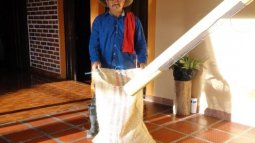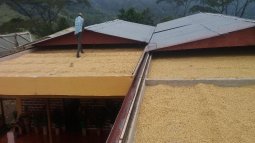From Alfredo:
I process the coffee with the help of my wife Elcira, and our son Alfredo and daughter Maria Fernanda.
We try picking mature coffee only between 3pm and 7 pm, then we select the best fruit by floating the harvested cherries in a tank with water.
The fermentation method is traditional leaving the coffee to ferment in the original farm beneficio (two cement tanks covered with a kind of porous brick tile); or, since 2016 using the new and up-to-date stainless-steel tanks. In 2016, we upgraded and doubled our wet process facilities with the installation of an environmentally amicable technology “Ecomill”.
The Ecomill fermentation is traditional. It uses two hygienically designed stainless-style hopers - with capacity of 1,500 to 2,000 kilos each. This technology is a mix between the mechanical demucilager BECOLSUB and the traditional tank hand agitated fermentation. It was developed by Cenicafe to produce high quality traditional fermentation coffee, while significantly reducing the use of water, and easing the management of wet by-products.
Normally I stop the fermentation time after 24 hours.
Once the fermentation is complete, coffee washing follows. In the old-fashioned tanks, washing requires manual agitation of the mass and several changes of water until the coffee/water comes out totally clean. This uses about 4.2 liters of water per kilo.
With the new Ecomill, washing is easier. Fermented coffee is discharged - using gravity and no water required to move the mass – directly to an integrated mechanical washer unit.
DRY PROCESS
All my coffee is sun Dry.
My dryer is installed on top of the house - a roof system known as Casa Elba. It has clean cement floors and zinc sheets for roofing. The ceiling can be rolled in and out to expose the coffee to the sun and/or protect it from rain and high temperatures. The Casa Elba is designed to allow air flow even when the roof is closed
Early in the morning I spread the wet coffee in the patio. This is known as oreado. At this point I rake every 30 minutes the mass to ensure the drying is homogeneous and the water-logged coffee layers on top and below are evenly exposed to the sun.
During this initial period, when the temperature gets too hot, I close the Casa Elda. As soon as the temperature goes down, I reopen it allowing the slow drying process to continue. Depending on the climate, this initial oreado phase lasts between 3 and 4 days. When moisture is removed gently, parchment will not burst open, enhancing quality of the green coffee.
After the first 4-day crucial period is complete, I allow the sun to heat the coffee with more intensely and the frequency of raking diminishes to 2 or 3 times a day. Normally it takes me about 15 to 20 days to complete the drying process.
When the coffee reaches a light green color, I know that it is ready for storage.
Prior to bagging it, I let the parchment to cool down.
I room dedicated to store parchment coffee. I use grainpro and new jute bags on is keep on top of wooden pallets.
PERSONAL STATEMENT
My work depends on the support I receive from the family. Because we work as a team I can implement additional quality process for my coffee.
We have participated in several competitions: four times my coffee has been in the CoE top 20: In 2010, 16th place; in 2013, 6th place; in 2014, 4th place and in 2015, 10th place.
I know that is possible to obtain good results if one applies to it. The additional money I have received from the competitions, has allowed me to improve the farm infrastructure particularly with an important investment in the wet process facilities.
For more information on Colombian coffee, visit our Colombia Origin Page.





